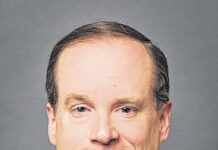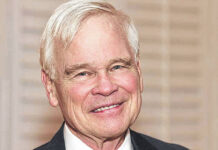Much like Old Main is an iconic symbol of UNC Pembroke for so many, Mary Livermore Library has represented our university’s academic mission since its doors opened in 1967. Over the ensuing decades, the library has evolved into a beacon of learning and education.
At the 1998 dedication of the newly expanded library, Dr. Clarence Toomer, then director of library services, remarked that “libraries like this one continue to stand at the forefront of information literacy. This library empowers our university community and improves the quality of intellectual life of the university and the region that surrounds it.”
Never have these words rung truer. Mary Livermore Library is — and will continue to be — a catalyst for changing lives through education. Yet to keep pace in a world where technology changes daily, where students need and demand immediate access to a rapidly expanding world of knowledge, and faculty require the very latest in their field of study, our university must respond and adapt if we are to continue honoring our seven founding fathers’ vision.
An intellectual hub, our library is the heart and soul of this university. It is the lifeblood of academia where research and discovery are tangible. Our growing student population deserves a facility that meets them where their needs exist, providing technology, support and resources in a space conducive to today’s learning environment.
This past summer, we began renovations of Mary Livermore Library’s first floor, outfitting it with new furniture and upgraded technology. Following the standard set by libraries across our nation, our dining partner relocated and renamed one of our food options into the library so students would have the choice to dine while continuing to study.
Hundreds of thousands of books are published each year in the U.S. With limited shelf space, it’s necessary for all libraries to occasionally remove materials to make room for new offerings. Very specific guidelines are in place to ensure our library removes only those books and journals outdated or no longer in use. In some cases, to make room for additional resources, we offer duplicate materials to local schools or to the Lumbee Tribe. Given our unique heritage as North Carolina’s Historically American Indian University, UNCP takes special care to preserve related materials housed in the Mary Livermore Library.
Increasingly, academic libraries are focused on providing access to technology-based resources rather than the ownership of print materials. For example, Mary Livermore Library recently expanded its digital offerings by adding more than 363,000 online books and publications to our present expansive collection of 500,000 print books and our wide selection of electronic scholarly journals. Last November, we announced the addition of one of the largest American Indian Law collections available. Accessible to the community in the library, this collection has more than 1.2 million pages and more than 1,000 titles. Indeed, our current total collection provides an unparalleled source of knowledge in the region.
In today’s world there is a wealth of information readily accessible at our fingertips. With Google and so many other resources available on smartphones — providing a fast and usually free alternative to traditional research methods — library users can satisfy most of their information needs online. And so, the library of tomorrow must be flexible and adaptive, offering unique solutions to bridge the gap in readily available content, encouraging complex and scholarly research, while serving as a destination for learning.
The library I used as an undergraduate no longer meets the needs of our 21st century students, who require an engaging environment where collaboration with faculty and peers is emphasized.
On any given day, I witness entire classes held in the library’s collaboration space, students surrounded by a wall of whiteboards solving complex mathematical equations, undergraduate researchers creating a presentation of their findings, faculty discussing innovative ideas over coffee, or local residents visiting to conduct their own research or to simply find a place to read or study. Our library maintains special collections with valuable connections to our rich history, and as resources become available our goal is to catalog these materials for easier access.
Mary Livermore Library must respond to our students, but equally important, it must also retain what makes it unique — a strong connection and tie to the community it has served for more than half a century.
Self-guided and assisted research, books, periodicals, and historically important collections and artifacts for community members, faculty, staff and students will remain a core part of the library’s mission. Notably, computers dedicated for community access remain available, and in fact, some are being upgraded.
I invite you to witness the transformation at guided tours available on Thursday from 1 to 5 p.m., March 4 from 9 a.m. to 1 p.m. and March 5 from 1 to 5 p.m.. If you prefer, we can schedule private and group tours at your convenience. We also hope to see you at our library open house on Sunday, April 7.
At my installation address, I referenced the importance of education’s power, promise and potential in a person’s life. Few places on UNC Pembroke’s campus signify this more than the Mary Livermore Library.
Growing up, riding bus 315 to Pembroke Elementary School each day, I would pass the buildings of what was then Pembroke State University. I still recall the impact this daily trip had on me, instilling a passion for education and a profound respect for this institution. I grew up in the shadow of Mary Livermore Library; my friends and I studied there. I assure you, it will grow to meet the needs of students, faculty and our community.
Importantly our library will remain a vital resource for this region.








